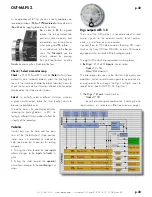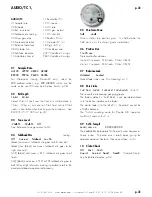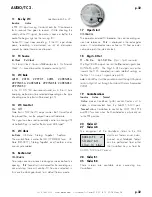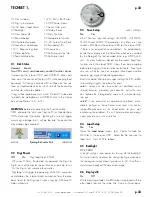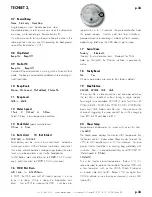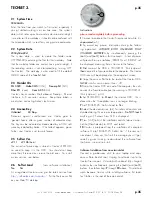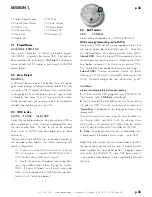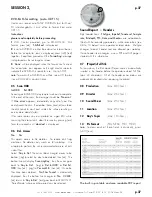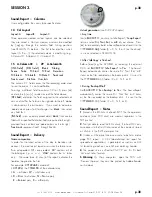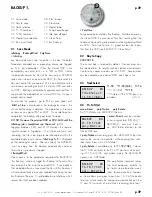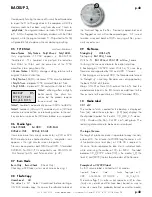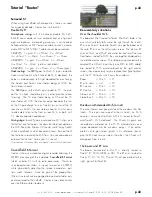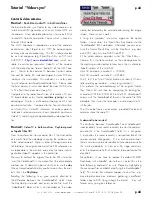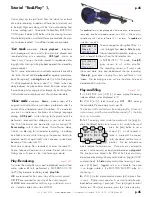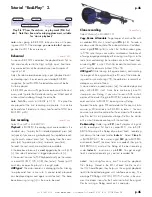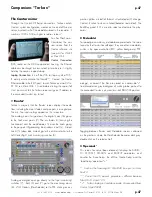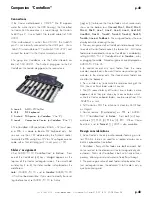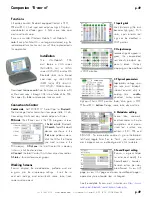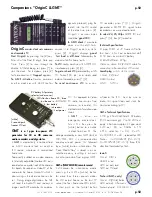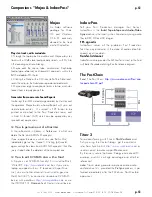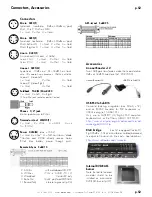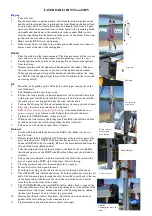
+33 4 7642 9550
www.aaton.com
User manual for Cantar-X1 & X2 v2.15 2008 March 28
p.44
p.44
Cantar & video cameras
Practice 1:
Real-time Audio-TC in both machines.
The best method to sync Cantar to any video camera is to
install a small LTC generator, such as an Aaton GMT, on
the camera. A less desirable alternative is to use an RF link
to send LTC from the camera to Cantar, which is slaved in
External Clock mode.
The GMT timecode is recorded on one of the camera’s
audio tracks; don’t forget to turn 'OFF' the automatic-gain
and any other audio processing. This LTC is later extracted
by an Avid composer (e.g. XpressPro v5.8+) or FCP (with
AUX-TC-FCP
http://www.videotoolshed.com
) which cor-
relate the continuous record-run Video-TC of the camera
with the discontinuous free-run Audio-TC of the GMT (see
pic.). Thanks to the common TC between Cantar's audio
files and the audio LTC indexed images, Avid or FCP can
‘autosync’ the two media. This method is in use for years
to sync telecine transfered AatonCode films. Please read
the Avid ‘autosync’ instructions about the track VA1A2 rules
in ‘The PostChain’ document (see p.51).
Compared to the radio transmission of record-run TC plus
TC break detection by Cantar,
real-time syncing
has two
advantages: it works in multicamera shooting, and it is low
power and fail safe. Compared to the
‘free-run discontinu-
ous Audio-TC as Video-LTC reference’
, it has the superiority
to let each video camera use its own record-run continuous
Video-TC, something much appreciated by video-post facili-
ties.
Practice 2:
Video-TC in both machines, DayStamp used
as TapeRef (Reel ID)
How to conform the Cantar audio files if the Avid editor
only works from the videotapes carrying the mixdown sent
to the video camera? There is neither a filetag to ensure a
link between the original tracks and the EDL reference nor
a usable date in the user-bits; every day the same indistin-
guishable Video-TC appears in the audio files.
The way to conform the original files to the EDL is to either
insert the VideoTapeID in the audio files (the old obsolete
method, see ‘
A demand to be resisted
’), or to use the
day
(like on AatonCoded shots) by another means than the user-
bits: that is the
DayStamp
.
Reading the following lines, give special attention to
the difference between the ‘AudioTapeRef’ which stores
the DayStamp into each and every audio file, and the
‘VideoTapeID’ label which is not recorded on the video
media but entered by the assistant-editor during the image
import. Here is how it works:
• Using the ‘workday’ rule which organizes the audio
folders, Cantar stores the ‘Month-Day’ DayStamp into the
‘AudioTapeRef’ iXML metadata. Alternately you can over-
write the Cantar ‘Month-Day’ with the ‘Day Rank’, e.g. day
one D001, day sixty two D062 (see PPR).
• The video camera operator writes the “Month-Day +
Camera ID + Cassette number” on the videotape box for
the digitizing assistant-editor to later key-in the six character
‘TapeID’ column of the Avid NLE.
April 18, camera-A, cassette 9 = 0418A9
April 18, camera-B, cassette 2 = 0418B2.
The (1 to 9 then A to Z) last character can identify 35 cas-
settes per day per camera... a very long workday!!
• To perform the auto-conforming of the original Cantar
files, Titan-3 first sorts them by comparing the leading four
characters (0418 or D062) of the Avid EDL ’VideoTapeID’
column with the ‘AudioTapeRef’ found in the audio file iXML
metadata, then it uses the timecode in- and out-points to fin-
ish the job.
The TC can be free-run or record-run, provided Cantar and
cameras share the same TC.
A demand to be resisted
The confusion between ‘AudioTapeRef’ and ‘VideoTapeID’
induces editors to ask sound recordists to enter the camera/
cassette IDs in the ‘AudioTapeRef’ field; this is not good:
1- quite often the sound recordist is warned too late of the
camera cassette change-over, 2- in a multi camera shoot,
there is no provision to enter double or triple camera cassette
IDs into the metadata, 3- how on a film stage could you
enter the video cassette ID of a transfer to be performed the
day after?
Nevertheless, if you have to replace the default MMDD
DayStamp with a TapeRef, do it either in Cantar (this is the
field following 'comments') or with Majax by highlighting
the concerned files and batch modifying the ’AudioTapeRef’
field. This insures that whatever happens to your files, e.g.
mono to poly conversion, mixdown, gathering in a different
folder, copy to DVD, flying through the internet..., they will
forever carry your given reference.
Tutorial "Video-sync"

